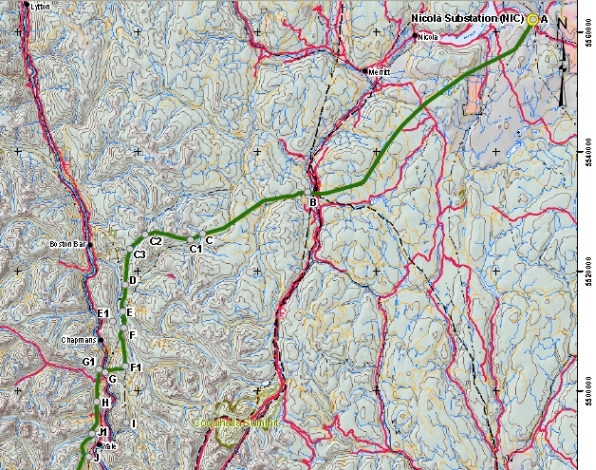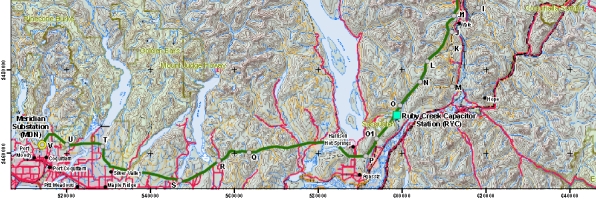

Proposed power line to Lower Mainland draws intense environmental scrutiny
Route map and other links at bottom of page
Scott Simpson
Vancouver Sun
Wednesday, November 19, 2008
Hydro line must be in place by 2014, officials say
The hunt for a route for a $725-million high-voltage power line to Metro Vancouver has begun in earnest, and it's a massive effort.
The British Columbia Transmission Corp. announced this week that it has formally submitted its application for an environmental certificate for a 500-kilovolt transmission line along a 255-kilometre route between Merritt and Coquitlam.
The Crown corporation wants the line in place by 2014, saying population growth in the Lower Mainland will soon drive electricity demand beyond the capacity of existing transmission lines to the B.C. Interior -- and that blackouts are likely if the line does not get built on time.
BCTC has submitted eight volumes of documents covering everything from the line's potential impact on a handful of spotted owls living east of Boston Bar to a shortage of tourist accommodation in areas along the route where numbers of migrant construction workers are concentrated.
The "Interior to Lower Mainland" line parallels an existing transmission line for more than two thirds of its length, but requires new alignment for 74 kilometers of the route.
It will also need to be widened to accommodate additional towers and wires for about 60 kilometres of the route.
The consultation phase is massive -- BCTC lists 126 federal, provincial and first nations contacts who are likely to comment and possibly raise concerns about the transmission corporation's plan for the route during a 180-day review period.
There are 30 fish species within the study area of the route, which will require 409 stream crossings and 97 road crossings. There are also 22 red- or blue-listed plant species, 11 rare and endangered bird species, two rare and endangered mammals, two rare and endangered reptiles, and four rare and endangered amphibians.
There are 60 first nations, and seven tribal councils or associations with an interest in the alignment of the route, 23 archaeological sites, 42 historic sites, and one paleological site.
BCTC senior project manager Melissa Holland is confident that the proposed route -- which includes a "thread the needle" section in a narrow Coast Mountain pass between critical habitat for spotted owls and grizzly bears -- is the one with the fewest environmental impacts.
"What we did find was a nice actual bench around the edge of the mountain where we can put the line. We wouldn't have been able to find that without hiking up and down the side of that mountain, which we did."
Gwen Farrell of the Western Canada Wilderness Committee is not so sure it's the best route.
"I'm surprised that the line will actually take away critical spotted owl habitat," Farrell said. "We are down to seven owls in the wild. I can't believe the project would even contemplate further encroaching on the habitat that's left."
Meanwhile, Grand Chief Stewart Phillip of the Union of B.C. Indian Chiefs said the chiefs have several concerns about the line -- not the least of which is a failure on the part of government to address the impacts first nations have suffered as a consequence of earlier transmission line construction along the route.
Phillip said the chiefs have flagged B.C.'s environmental assessment process as being "grossly deficient" and called upon Premier Gordon Campbell to work with first nations to amend the process "in a fashion that does recognize and acknowledge our aboriginal title interests."
ssimpson@vancouversun.com
© The Vancouver Sun 2008
  |
Interior-Lower Mainland Transmission Project Preferred Route Map here
Environmental Assessment Office file on ILM project here
Posted by Arthur Caldicott on 20 Nov 2008